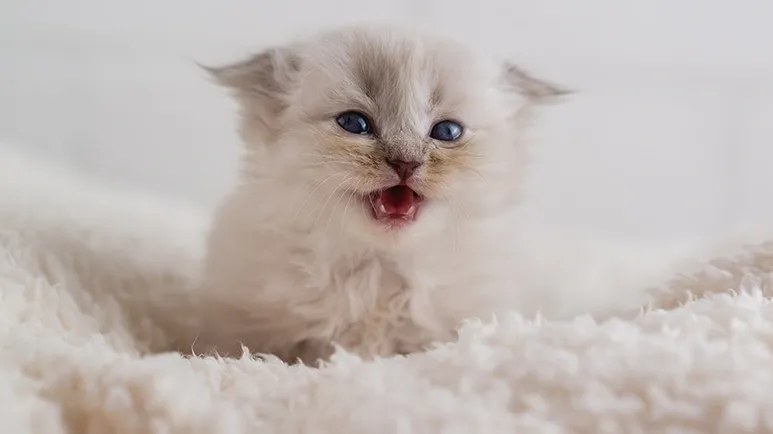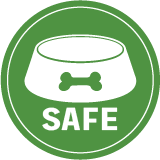Purr-fect Pearly Whites — A Guide to Your Kitten's Teething Journey
If your kitten is chewing more than usual or acting a little cranky, they're probably teething. Don't worry — this guide will help you understand exactly what's going on and how you can help your kitten through it.

STORY AT-A-GLANCE
- Kittens experience two teething phases — first with the eruption of baby teeth, then the transition to 30 permanent adult teeth between 3 and 6 months of age
- Common signs of teething include increased chewing, drooling, bad breath, gum irritation, and occasional bleeding, all of which usually resolve as teething progresses
- Soft toys, frozen washcloths, and gentle teething aids help soothe sore gums and redirect chewing behavior away from dangerous or inappropriate household objects
- Switching to wet food during teething makes eating easier for sensitive mouths and provides long-term health benefits like better hydration and improved protein intake
- Early dental care, including gentle brushing and vet checkups, helps prevent issues like retained baby teeth, gum disease, and misaligned bites, promoting lifelong oral health
Welcoming a kitten into your home is a joyful and transformative experience. These small, inquisitive companions quickly capture our hearts with their playful antics and affectionate nature. Yet amid the cuddles and the curiosity, kittens undergo several critical developmental stages, one of the most important being teething.
Much like human infants, kittens go through a teething process that involves two distinct phases — the eruption of baby teeth, followed by the loss of those baby teeth and the emergence of permanent adult teeth. Understanding this journey is essential for providing appropriate care, ensuring comfort, and supporting your kitten's long-term oral health.
Understanding Your Kitten's Teeth
Just like humans, kittens are not born with teeth. At birth, their nutritional needs are met exclusively by nursing from their mother. Since solid food is unnecessary at this stage, teeth are not required.
However, as kittens grow and begin the process of weaning, their bodies prepare for this dietary shift by developing a set of temporary teeth, commonly known as deciduous or baby teeth. These first set of teeth that emerge in kittens typically erupt around the second to fourth week of life.1
Baby teeth are notably sharp and fine, designed to help young kittens transition to solid food. They play a crucial role in early development, but they are not permanent. As the kitten matures, these teeth will fall out and be replaced by a more durable set of adult teeth.
The Kitten Teething Timeline
A clear understanding of the teething timeline enables you to monitor your kitten's development and anticipate any potential issues.2
- Phase One — Eruption of Baby Teeth
- Zero to two weeks — Kittens are born without teeth.
- Two to three weeks — The first baby teeth to emerge are the incisors, which are the small, front teeth used for grasping.
- Three to four weeks — Canine teeth, also known as fangs, begin to appear.
- Four to six weeks — Premolars emerge toward the sides and back of the mouth.
- Six to eight weeks — By this age, most kittens will have a full set of 26 baby teeth, including 12 incisors, four canines, and 10 premolars.
- Phase Two — Transition to Adult Teeth
- Three to four months — Their baby incisors begin to fall out and are replaced by adult incisors.
- Four to five months — Canines and premolars are shed and replaced with permanent teeth. The first molars begin to emerge.
- Five to seven months — The final adult teeth come in, resulting in a complete set of 30 permanent teeth — 12 incisors, four canines, 10 premolars, and four molars. By 6 to 7 months of age, your kitten should have a full set of adult teeth.3
Physical and Behavioral Signs of Teething
Although teething is a natural developmental process, it is not without discomfort. During this period, your kitten may exhibit certain physical and behavioral changes, including:4,5
- Increased chewing — Kittens instinctively chew on various objects to soothe the discomfort associated with erupting teeth. Chewing on soft toys or household items such as blankets is a common self-soothing behavior.
- Drooling — An increase in saliva production is typical during teething.
- Mild gum inflammation — You may observe redness or swelling of the gums as new teeth push through.
- Swollen or bleeding gums — Occasional, minor bleeding may occur, particularly around loose baby teeth, or when a tooth is lost.
- Bad breath — Temporary bad breath, often referred to as "kitten breath," can be associated with teething.
- Irritability or sensitivity — Some kittens may appear cranky, more withdrawn, or sensitive, especially when their mouths are touched.
These symptoms are generally mild and resolve as the teething process progresses. However, if your kitten exhibits extreme discomfort, refuses to eat, or displays unusual behavior, veterinary consultation is advised.
Appropriate Chew Toys Helps with the Teething Process
Offering suitable chew toys is one of the most effective ways to help alleviate teething discomfort. Ideal options include:
- Soft plush toys — These are gentle on tender gums while satisfying the urge to chew.
- Textured teething toys — Designed specifically for kittens, these toys provide tactile stimulation and relief.
- Frozen washcloths — Soaking a clean washcloth in water and freezing it creates a soothing, crunchy texture ideal for sore gums.
- Rubber cat toys — Flexible and safe materials allow for satisfying chewing without risk of injury.
- Natural chews — Such as silvervine sticks (an alternative to catnip), cat grass or freeze dried chicken or duck necks (with proper supervision of course) are known to naturally promote chewing and dental health.
During the teething process, you may need to watch your kitten carefully. Make sure they don't chew on inappropriate items such as electrical cords, shoes, or your fingers. These habits can be harmful and difficult to correct later.
Nutritional Considerations During Teething
Eating can become challenging for some kittens during teething, particularly if their gums are sore or if loose teeth interfere with chewing. Ideally, kittens should not be fed kibble as it can be tough on their sensitive teeth.
Instead, give them soft, wet or moist food (including raw diets or balanced cooked diets) that are easier to chew and swallow. Additionally, they provides higher moisture content and better aligns with a cat's natural dietary needs.6 For some pet parents, the transition to wet food during teething becomes a permanent dietary choice, as it offers ongoing health benefits for hydration and nutrient absorption.
Additionally, adding probiotics to your kitten's diet also helps ensure a healthy mouth and gut as your kitten matures.
Building Good Oral Hygiene Habits Early
Though your kitten's mouth may be sensitive during teething, this period presents a valuable opportunity to introduce tooth brushing in a gentle and positive way. Starting oral hygiene early lays the foundation for lifelong dental care. Make sure to use a gentle finger brush or a soft cloth, and gently massage the gums and teeth.
Always use a nontoxic toothpaste made especially for cats; never use human toothpaste as they can contain artificial sweeteners such as xylitol which may be toxic to cats. A small amount of coconut oil can be used as a safe alternative to toothpaste for cats.
It's best to keep early brushing attempts brief and pleasant to build trust. Use treats and praise to make the experience rewarding. As your kitten grows, you can transition to more thorough brushing with a toothbrush.7
Potential Dental Complications to Watch For
Most kittens go through the teething process without issues, but there are some that encounter complications that require veterinary attention. For example, there are instances when a baby tooth does not fall out when the corresponding adult tooth emerges.
This condition, known as retained deciduous teeth, can lead to overcrowding, misalignment, gum irritation, premature tooth decay, and infections. Your vet will recommend extracting retained teeth to prevent these complications and promote healthy alignment. Other dental issues that may occur include:8
- Gingivitis and periodontal disease — Even young cats are susceptible to gum disease if plaque accumulates on the teeth. Signs include red or bleeding gums and persistent bad breath. Early dental care, including brushing and professional cleanings, can prevent progression. Alternative treatments such as cold laser therapy and herbal supplements can also help with gingivitis.
- Malocclusion (misaligned teeth) — This can interfere with eating and cause mouth injuries. If identified early, corrective options may be available.
Maintaining Oral Health Beyond the Kitten Stage
Veterinary dental examinations are a vital component of your kitten's health regimen. Kittens should receive veterinary check-ups every three to four weeks during early development, then annual exams can be done when they're 6 months and older. If you notice any of the following symptoms, consult with your veterinarian:
- Persistent bleeding gums
- Unusual swelling or growths in the mouth
- Difficulty eating or dropping food
- Extra or overlapping teeth
- Foul-smelling breath
- Drooling or pawing at the mouth
Prompt intervention can prevent long-term dental issues and ensure your kitten's comfort. Once the teething stage is complete and all adult teeth are in place, continued dental care remains essential for your cat's health.
- Brushing should be done ideally every day, or at minimum three times per week.
- Select veterinarian-approved dental treats or chews that reduce plaque.
- Provide your cat with natural chews such as silvervine or cat grass.
- Provide a healthy natural diet and avoid giving your kitten sugary, crunchy, or hard human foods that can damage their teeth.
- Consider adding probiotics to your cat's diet to support healthy mouth and gut bacteria.
- Discuss with your veterinarian whether your cat requires professional dental cleaning based on their condition.
Nurturing a Lifetime of Oral Health
Teething is an essential stage in your kitten's growth and development. While it may involve brief periods of discomfort and adjustment, it also provides an opportunity to establish lifelong health habits.
By offering appropriate toys, monitoring dietary needs, introducing brushing routines, and attending regular veterinary checkups, you can support your kitten through every phase of dental development. These early interventions not only ensure comfort during teething but also lay the groundwork for a future of strong teeth, healthy gums, and overall well-being.
A healthy mouth leads to a happier cat — and a lifetime of playful moments, affectionate purrs, and bright, toothy smiles.










